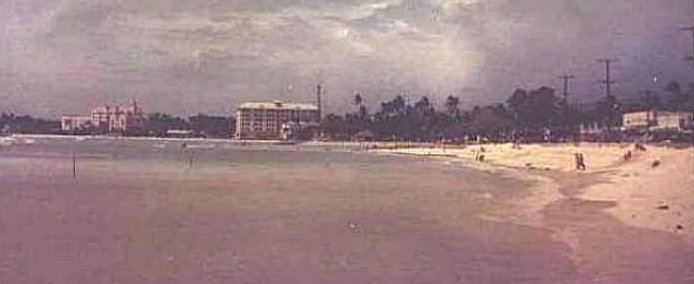
Before the explosion of tourism to the islands the beaches were very beautiful.

Hawaii's most famous beach was virtually empty most of the time. The long wave surfing action was due to the beach extending out as shallow water almost half a mile. The two main hotels were the Royal Hawaiian (the Pink Palace) and the Moana. Today you can hardly find these two in the skyline, totally surrounded by the high-rise hotels.
The Moana had the famous banyan tree lanai veranda.
Does the Moana still exist somewhere between the high-rise structures? The Royal Hawaiian is to the left.
Travel to the island was still difficult, and only honeymooners and retired folks came to see it. The SS Lurline of the Matson lines brought the tourists one week and returned two weeks later to pick them up. The arrival of the Lurline created a bit of excitement on the island.
The Lurline arriving at the famous Aloha Tower pier.
The famous profile of Diamondhead, the long extinct volcanic crater. From the air this can be seen to be the edge of a circular crater. The Navy maintained a weather station on the far edge. It got its name when quartz deposits were mistaken for diamonds.
(picture to come)
This was an almost deserted stretch of beautiful beach along the south-west coast line, The road came to a dead end near the tip of the island. There was a dry lava cave there. The beach was quite steep into the water and the waves were strong, but it was great sand.
This small cove on the north-east side of the island was considered too dangerous a beach to swim due to the severe undertow, and had been declared "off limits" to military personnel. But the waves crashed with great force since it had no extended shallow region like Waikiki. As a result the beach sand was very fine. The peninsula of Kaialua can be seen in the background.
This was a pristine cove formed by a volcano crater breaking open to the sea. The reef across the center separated the shallow inner section from the deeper outer region. The inner section had filled with sand and coral heads (the dark areas). Scuba diving was very rewarding here since it attracted many species of tropical fish. Several movies used this setting, including Elvis' "Blue Hawaii." There was only one small restroom building in the palm trees, and there was a foot path to get down to it. Today there is a concession stand and a road down, and the beach is mobbed.
This section of beach was a military reservation on the west coast of the island. It was frequented mainly by personnel from the army at Fort Shafter and airforce at Wheeler Field since their bases were close by. This was a great natural surfing beach. It was a rough life, but someone had to do it.
This beach was near downtown Waikiki, and extended from the Alawai Canal to the front of the Halikulani Hotel. (That hotel was torn down to make room for the Reef Hotel) This section of beach was also a military reservation with signs for only military personnel to enter through a gate in a chain-link fence. Fort DeRussy had been constructed as a shore defense gun emplacement, and the huge two-story-high concrete ramparts of the gun mounts were still there hidden behind mounds of sand and palm trees. A concession stand and shower/dressing rooms were provided inside the ramparts. The base was also available as an R&R center with a dance pavilion and small hotel.
On the north side of the island, Kaialua was the best beach for family outings. The beach was gently sloped into the water and shallow extended out quite a ways. This was a "locals" beach since the tourists stayed mainly near Waikiki. It was a well kept secret. The Kaneohe Marine air base can be seen in the distance.